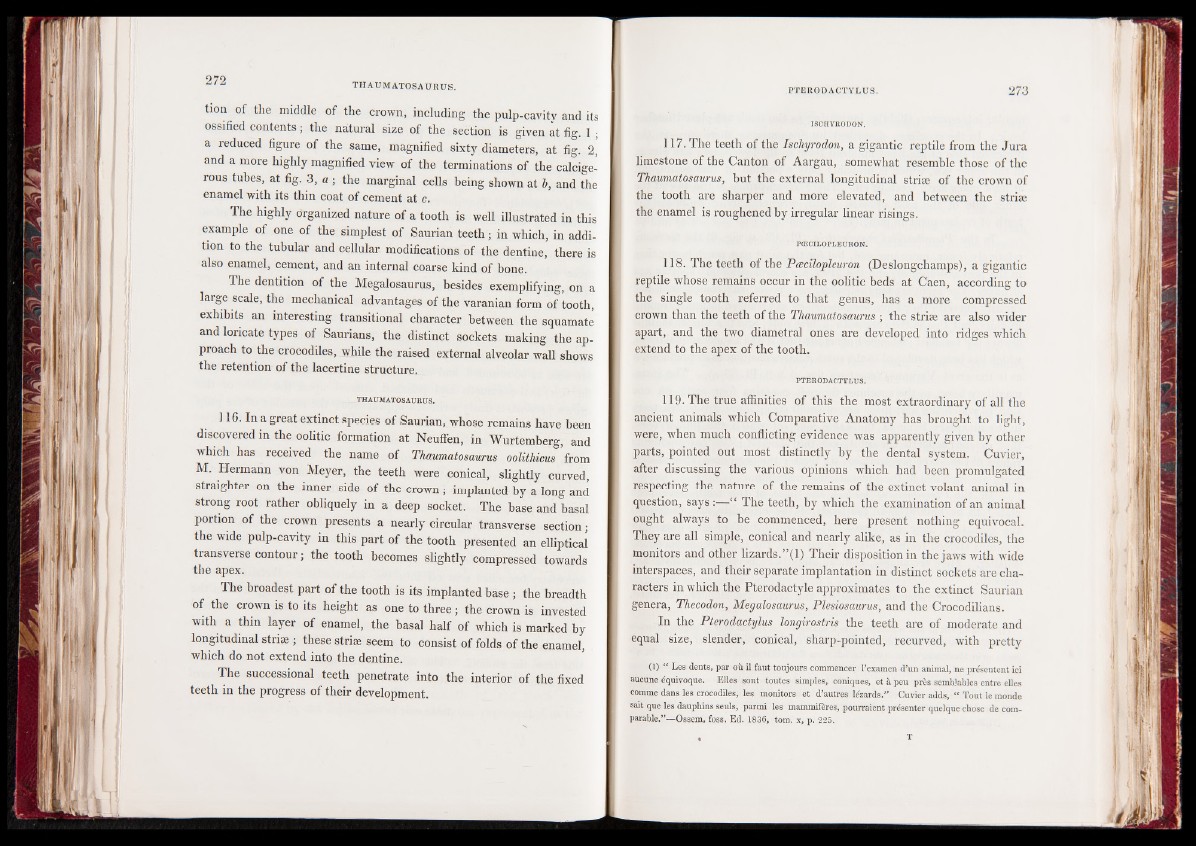
tion of the middle of the crown, including the pulp-cavitv and its
ossified contents; the natural size of the section is given at fig. 1 !
a reduced figure of the same, magnified sixty diameters, at fig. 2,
and a more highly magnified view of the terminations of the calcige-
rous tubes, at fig. 3, a ; the marginal cells being shown at b, and the
enamel with its thin coat of cement at c.
The highly organized nature of a tooth is well illustrated in this
example of one of the simplest of Saurian teeth; in which, in addition
to the tubular and cellular modifications of the dentine, there is
also enamel, cement, and an internal coarse kind of bone.
The dentition of the Megalosaurus, besides exemplifying, on a
large scale, the mechanical advantages of the varanian form of tooth,
exhibits an interesting transitional character between the squamate
and loricate types of Saurians, the distinct sockets making the approach
to the crocodiles, while the raised external alveolar wall shows
the retention of the lacertine structure.
THAUMATOSAURUS.
116. In a great extinct species of Saurian, whose remains have been
discovered in the oolitic formation at Neuffen, in Wurtemberg, and
which has received the name of Thaumatosaurus oolithicus from
M. Hermann von Meyer, the teeth were conical, slightly curved,
straighter on the inner side of the crown ; implanted by a long and
strong root rather obliquely in a deep socket. The base and basal
portion of the crown presents a nearly circular transverse section •
the wide pulp-cavity in this part of the tooth presented an elliptical
transverse contour; the tooth becomes slightly the apex. compressed towards
The broadest part of the tooth is its implanted base ; the breadth
of the crown is to its height as one to three; the crown is invested
with a thin layer of enamel, the basal half of which is marked by
longitudinal striae ; these striae seem to consist of folds of the enamel,
which do not extend into the dentine.
The successional teeth penetrate into the interior of the fixed
teeth in the progress of their development.
ISCHYRODON,
117. The teeth of the Ischyrodon, a gigantic reptile from the Jura
limestone of the Canton of Aargau, somewhat resemble those of the
Thaumatosaurus, but the external longitudinal striae of the crown of
the tooth are sharper and more elevated, and between the striae
the enamel is roughened by irregular linear risings.
PCECILOPLEURON.
118. The teeth of the Pcecilopleuron (Deslongchamps), a gigantic
reptile whose remains occur in the oolitic beds at Caen, according to
the single tooth referred to that genus, has a more compressed
crown than the teeth of the Thaumatosaurus ; the striae are also wider
apart, and the two diametral ones are developed into ridges which
extend to the apex of the tooth.
PTERODACTYLUS.
119. The true affinities of this the most extraordinary of all the
ancient animals which Comparative Anatomy has brought to light,
were, when much conflicting evidence was apparently given by other
parts, pointed out most distinctly by the dental system. Cuvier,
after discussing the various opinions which had been promulgated
respecting the nature of the remains of the extinct volant animal in
question, says “ The teeth, by which the examination of an animal
ought always to be commenced, here present nothing equivocal.
They are all simple, conical and nearly alike, as in the crocodiles, the
monitors and other lizards.”(1) Their disposition in the jaws with wide
interspaces, and their separate implantation in distinct sockets are characters
in which the Ptérodactyle approximates to the extinct Saurian
genera, Thecodon, Megalosaurus, Plesiosaurus, and the Crocodilians.
In the Pterodactylus longirostris the teeth are of moderate and
equal size, slender, conical, sharp-pointed, recurved, with pretty
(1) “ Les dents, par où. il faut toujours commencer l’examen d’un animal, ne présentent ici
aucune equivoque. Elles sont toutes simples, coniques^ et à peu près semblables entre elles
comme dans les crocodiles, les monitors et d’autres lézards.” Cuvier adds, “ Tout le monde
sait que les dauphins seuls, parmi les mammifères, pourraient présenter quelque chose de comparable.”—
Ossem. foss. Ed. 1836, tom. x, p. 225.
T